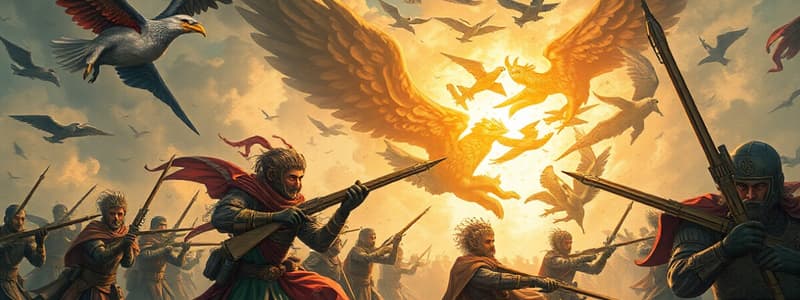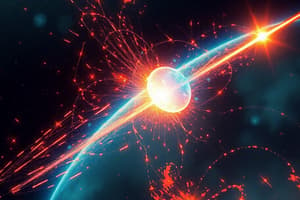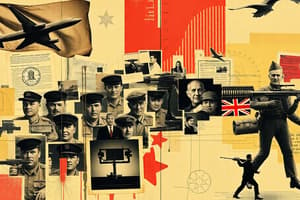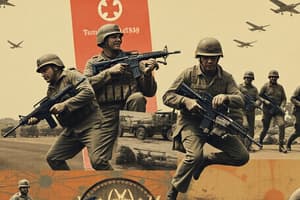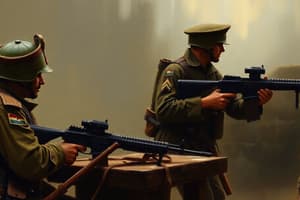Podcast
Questions and Answers
What is the role of leadership in combat power?
What is the role of leadership in combat power?
- It defines the strict hierarchy of military units.
- It serves as the activity of influencing people to accomplish missions. (correct)
- It has no significant impact on the combat effectiveness.
- It is solely focused on strategy and tactics.
How does leadership manifest in military operations?
How does leadership manifest in military operations?
- Through strict adherence to orders without flexibility.
- By avoiding conflict and seeking diplomatic solutions.
- As an unrelenting will to accomplish the mission. (correct)
- As individuals' ability to understand tactics only.
What is the primary source of lethality in combat?
What is the primary source of lethality in combat?
- Logistics and supply chains.
- Firepower and the ability to produce lethal force. (correct)
- Leadership and morale.
- Intelligence and surveillance.
Which of the following enhances firepower on the battlefield?
Which of the following enhances firepower on the battlefield?
What is a consequence of utilizing firepower effectively?
What is a consequence of utilizing firepower effectively?
How do leaders increase the effectiveness of firepower?
How do leaders increase the effectiveness of firepower?
What is the relationship between leadership and command and control (C2)?
What is the relationship between leadership and command and control (C2)?
Which dynamic of combat power does leadership primarily influence?
Which dynamic of combat power does leadership primarily influence?
How does using information in combat affect enemy forces?
How does using information in combat affect enemy forces?
What does mobility allow military forces to do?
What does mobility allow military forces to do?
What impacts the mobility of an armored brigade combat team (BCT)?
What impacts the mobility of an armored brigade combat team (BCT)?
How can leaders enhance their understanding of mobility in relation to enemy forces?
How can leaders enhance their understanding of mobility in relation to enemy forces?
What is a direct effect of weather on military mobility?
What is a direct effect of weather on military mobility?
Which of the following scenarios could reduce the mobility of land forces?
Which of the following scenarios could reduce the mobility of land forces?
Which factor does NOT enhance the relative mobility of military units?
Which factor does NOT enhance the relative mobility of military units?
Why is intelligence critical for exploiting mobility in a military context?
Why is intelligence critical for exploiting mobility in a military context?
What is the primary purpose of interorganizational cooperation?
What is the primary purpose of interorganizational cooperation?
Which of the following is NOT a core activity performed by special operations forces?
Which of the following is NOT a core activity performed by special operations forces?
How do conventional forces contribute during large-scale combat operations?
How do conventional forces contribute during large-scale combat operations?
What is a key aspect of the integration between conventional and special operations forces?
What is a key aspect of the integration between conventional and special operations forces?
Why is understanding command and support relationships essential in operations involving conventional and special operations forces?
Why is understanding command and support relationships essential in operations involving conventional and special operations forces?
Which factor is critical when conducting operations that include multinational forces?
Which factor is critical when conducting operations that include multinational forces?
What type of warfare is included within the core activities of special operations forces?
What type of warfare is included within the core activities of special operations forces?
What does the integration of conventional and special operations forces aim to reduce during operations?
What does the integration of conventional and special operations forces aim to reduce during operations?
What is the primary goal of peer threats in their approach to conflict?
What is the primary goal of peer threats in their approach to conflict?
Which of the following statements about peer threats' willingness is correct?
Which of the following statements about peer threats' willingness is correct?
What method do peer threats use to influence combat and operational decisions?
What method do peer threats use to influence combat and operational decisions?
Which of the following is NOT classified as a method used by peer threats?
Which of the following is NOT classified as a method used by peer threats?
Peer threats believe they can achieve long-term objectives because of which of the following factors?
Peer threats believe they can achieve long-term objectives because of which of the following factors?
During conflict, peer threats aim to achieve their objectives by causing what effect in relation to U.S. forces?
During conflict, peer threats aim to achieve their objectives by causing what effect in relation to U.S. forces?
In what area do peer threats prefer to exploit vulnerabilities?
In what area do peer threats prefer to exploit vulnerabilities?
What differentiates the information warfare methods of peer threats from those of the United States?
What differentiates the information warfare methods of peer threats from those of the United States?
What is the primary role of forward-stationed rotational forces?
What is the primary role of forward-stationed rotational forces?
Which statement about the Army Reserve Components is true?
Which statement about the Army Reserve Components is true?
What factor must planners consider regarding Reserve Components mobilization?
What factor must planners consider regarding Reserve Components mobilization?
What does the Army use echelons for?
What does the Army use echelons for?
What is a major capability of Reserve Components during armed conflict?
What is a major capability of Reserve Components during armed conflict?
Which echelon typically has greater experience in command teams and can coordinate complex operations?
Which echelon typically has greater experience in command teams and can coordinate complex operations?
What percentage of the Army’s mobilization base expansion capability comes from Reserve Components?
What percentage of the Army’s mobilization base expansion capability comes from Reserve Components?
Which statement accurately describes the mobility of forward-stationed rotational forces?
Which statement accurately describes the mobility of forward-stationed rotational forces?
How do cyberspace capabilities primarily support decision-making in land operations?
How do cyberspace capabilities primarily support decision-making in land operations?
Which of the following is NOT a way land capabilities enable maritime operations?
Which of the following is NOT a way land capabilities enable maritime operations?
What role does networking sensors and fires platforms play in land operations?
What role does networking sensors and fires platforms play in land operations?
Why is integrating all-source intelligence important for land operations in maritime environments?
Why is integrating all-source intelligence important for land operations in maritime environments?
What is a key benefit of enabling rapid communication to audiences through social media in military operations?
What is a key benefit of enabling rapid communication to audiences through social media in military operations?
What is one of the primary advantages of providing and protecting transportation of units over strategic distances?
What is one of the primary advantages of providing and protecting transportation of units over strategic distances?
What misconception might people have about the Army's force posture?
What misconception might people have about the Army's force posture?
Which activity is a primary focus when attacking enemy networks in cyberspace?
Which activity is a primary focus when attacking enemy networks in cyberspace?
Flashcards
Leadership
Leadership
The activity of influencing people to accomplish missions and improve organizations.
Combat Power
Combat Power
The total effectiveness of a military unit against enemy forces.
Command and Control (C2)
Command and Control (C2)
The exercise of authority and direction by a commander over assigned forces.
Firepower
Firepower
Signup and view all the flashcards
Direct and Indirect Fires
Direct and Indirect Fires
Signup and view all the flashcards
Mass and Precision
Mass and Precision
Signup and view all the flashcards
Movement and Maneuver
Movement and Maneuver
Signup and view all the flashcards
Lethal Force
Lethal Force
Signup and view all the flashcards
Psychological Effects
Psychological Effects
Signup and view all the flashcards
Information Manipulation
Information Manipulation
Signup and view all the flashcards
Mobility
Mobility
Signup and view all the flashcards
Terrain Impact on Mobility
Terrain Impact on Mobility
Signup and view all the flashcards
Environmental Monitoring
Environmental Monitoring
Signup and view all the flashcards
Enemy Influence on Mobility
Enemy Influence on Mobility
Signup and view all the flashcards
Maneuver Warfare
Maneuver Warfare
Signup and view all the flashcards
Peer Threats
Peer Threats
Signup and view all the flashcards
Information Warfare
Information Warfare
Signup and view all the flashcards
Comparative Advantage
Comparative Advantage
Signup and view all the flashcards
Methods of Peer Threats
Methods of Peer Threats
Signup and view all the flashcards
Systems Warfare
Systems Warfare
Signup and view all the flashcards
Isolation
Isolation
Signup and view all the flashcards
Sanctuary
Sanctuary
Signup and view all the flashcards
Sensitivity to Casualties
Sensitivity to Casualties
Signup and view all the flashcards
Interorganizational Cooperation
Interorganizational Cooperation
Signup and view all the flashcards
Civil-Military Integration
Civil-Military Integration
Signup and view all the flashcards
Integration of Forces
Integration of Forces
Signup and view all the flashcards
Mission-Driven Relationships
Mission-Driven Relationships
Signup and view all the flashcards
Conventional Forces Role
Conventional Forces Role
Signup and view all the flashcards
Special Operations Forces Contributions
Special Operations Forces Contributions
Signup and view all the flashcards
Deep Operations Importance
Deep Operations Importance
Signup and view all the flashcards
Unity of Effort
Unity of Effort
Signup and view all the flashcards
Rotational Forces
Rotational Forces
Signup and view all the flashcards
Global Response Capability
Global Response Capability
Signup and view all the flashcards
Army Reserve Components
Army Reserve Components
Signup and view all the flashcards
Mobilization Requirements
Mobilization Requirements
Signup and view all the flashcards
Echelons in the Army
Echelons in the Army
Signup and view all the flashcards
Higher Echelons
Higher Echelons
Signup and view all the flashcards
Reconstitution Operations
Reconstitution Operations
Signup and view all the flashcards
Joint Capabilities
Joint Capabilities
Signup and view all the flashcards
Cyberspace Operations
Cyberspace Operations
Signup and view all the flashcards
Common Operational Picture (COP)
Common Operational Picture (COP)
Signup and view all the flashcards
Targeted Influence Operations
Targeted Influence Operations
Signup and view all the flashcards
Joint All-Source Intelligence
Joint All-Source Intelligence
Signup and view all the flashcards
Maritime Choke Points
Maritime Choke Points
Signup and view all the flashcards
Long-Range Fires Systems
Long-Range Fires Systems
Signup and view all the flashcards
Operational Reach
Operational Reach
Signup and view all the flashcards
Logistics Support for Maritime Forces
Logistics Support for Maritime Forces
Signup and view all the flashcards
Study Notes
Chapter 2: Generating and Applying Combat Power
- Army forces integrate capabilities and synchronize warfighting functions to generate combat power
- Successful combat power application requires understanding the enemy and friendly capabilities
- Leaders must understand the strategic environment and threat methods
- Understanding specific enemy situations is crucial
- Understanding how Army forces enable joint operations across multiple domains is vital
Warfighting Functions
- Warfighting functions are a group of tasks and systems united by a common purpose (ADP 3-0)
- Command and control (C2)
- Movement and maneuver
- Intelligence
- Fires
- Sustainment
- Protection
- Warfighting functions provide an intellectual organization for critical capabilities at all echelons
- Warfighting functions are relevant to all types of units and are not branch-specific
Command and Control (C2) Warfighting Function
- Command and control (C2) warfighting function synchronizes and converges all combat power elements (ADP 3-0)
- C2 involves people, processes, networks, and command posts
- Critical for effective decision making and operations tempo
- Supports situational understanding, decision making, and communication networks
- C2 synchronizes other warfighting functions
Movement and Maneuver Function
- Movement and maneuver function moves and employs forces to achieve a relative advantage over the enemy (ADP 3-0)
- Direct fire and close combat are inherent aspects of maneuver
- Force projection is also a part of this function
- Movement is necessary to strategically position and disperse the force
- Maneuver achieves surprise, shock, and momentum
- Requires reconnaissance, surveillance, and security operations
- Supports intel collection and info advantages
- Sustainment is crucial to the effectiveness of the movement and maneuver function
Intelligence Function
- Facilitates understanding of the enemy, terrain, weather, and other aspects of the operational environment (ADP 3-0)
- Involves analyzing info from all sources, including other warfighting functions
- Supportive of force generation, situational understanding, targeting, and info collection
Fires Function
- Creates and converges effects across all domains against the adversary (ADP 3-0)
- Includes lethal and non-lethal effects from Army and joint forces
- Not exclusive to any particular branch or function
- May simultaneously support other warfighting functions
Sustainment Function
- Provides support and services to ensure freedom of action, extended operational reach, and endurance (ADP 3-0)
- Uses capabilities from all domains
- Employs joint and strategic integration
- Critical for operation continuity and resource delivery
Protection Function
- Maintains combat power by preventing or mitigating threats to preserve freedom of action (ADP 3-37)
- Focuses on ensuring enemy detection or effects are mitigated
- Requires appropriate prioritisation of protection efforts with tempo and main efforts
- Important measures include operations security, dispersion, deception, and survivability measures.
Combat Power
- The total means of destructive and disruptive force a military unit can apply against an enemy (JP 3-0)
- Consists of leadership, firepower, information, mobility, and survivability
Leadership
- Most vital aspects of combat power is leadership
- Influences people through purpose, direction, and motivation
Firepower
- Primarily used as the source of lethality
Studying That Suits You
Use AI to generate personalized quizzes and flashcards to suit your learning preferences.
